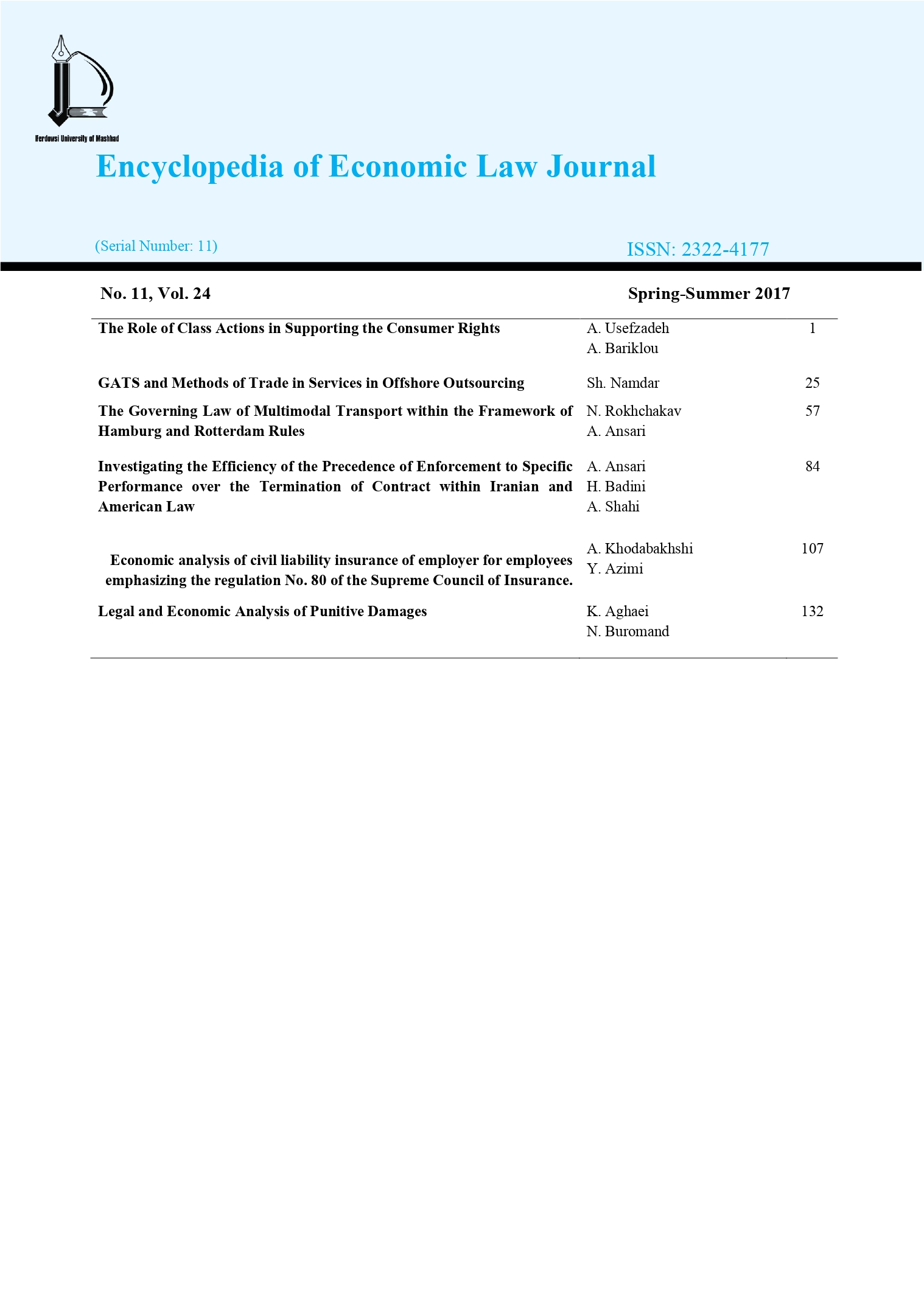Document Type : Scientific research
Author
islamic azad university of yazd
Abstract
Introduction:
World trade organization (WTO) introduces “ trade in services” as the most dynamic segment of international trade. Developing countries and transition economics have played an increasingly important role in this area. The WTO’s General Agreement on Trade in Services (GATS) is the only set of multilateral rules covering international trade in services. While services account for an overwhelming share of overall economic activities, “offshore outsourcing” in the service sector being, formed many decades ago, seems to be an important issue for lots of countries. This article concentrates on surveying “offshore outsourcing” mode of supply in comparison with four modes of supply that are mentioned in GATS. Empirical analysis on the mode of supply in offshore outsourcing is very limited.
Theoretical Framework
Business structures and economic entities responded to change in technology by relying on outside entities to perform various functions. In the past years, only the manufacturing and manual labor-based functions were susceptible to outsourcing in foreign countries. Today, advancement in communications, technology, transportation, and free trade has widened the range of functions that can be sent to the overseas vendors. Lawmakers have acknowledge that offshore outsourcing may involve issues related to privacy, labor rights, intellectual property, immigration, environmental protection, taxation, export controls, and national security. One of the important issues in the field of service sector of economy is the mode of supply in service.
Methodology
At the very early stages of the emergence of “offshore outsourcing” phenomenon, professionals from different areas of science were attracted to the impacts of this process on the world economy. The Organization for Economic Co-operation and Development (OECD) has published different works on offshore outsourcing aspects. In this research, the descriptive method has been used in defining and introducing offshoring and trade in separate services as well as an integrated economical processes. However, at the core of the research when the writer is developing new concepts about the modes of supply in offshore outsourcing and re-interpreting the existing modes of supply, the conceptual analysis as the, method of research is used. In both parts, the documentary and publication research method is used to gather data.
Results and Discussions:
The way or modes of supply in offshore outsourcing is not exactly according to one of the four modes of supply in GATS. It has different reasons, some of them I think refer to the economic theory called “ the three-sector theory, while some others are related to” the integrated nature of this economic process. GATS identifies four different ways or “modes” of supplying services. As for many services, remote supplying is impossible, the first mode is not often taken but in offshore outsourcing of financial services, telephone centers and some other services that can transfer via the wire or wire less technology and do not need to face to face connection, offshore outsourcing is possible and quite common. The second mode is the most liberalized one in terms of commitment, while the third mode is more open and has the largest share in global value chains. However, offshore outsourcing in manufacturing has more similarities with mode (3).Mode (4) that refers to presence of persons of one WTO member in the territory of another for the purpose of providing a service is not common in offshore outsourcing. Mode of supply for offshore-outsourcing in the service sectors seems a lot more complicated than the four existing modes of supply of services in GATS. For a service to be effectively produced or delivered, the proximity between the consumer and the supplier is often a necessary condition.Thus, in addition to cross-border supply (mode 1), GATS also covers cases where consumers move outside their home territory to consume services (mode 2- consumption abroad), and cases where suppliers move to the territory of the consumers to provide their services, whether by establishing a commercial presence abroad (mode 3), or through the presence of natural persons (mode 4).
Conclusion
Our studies and findings in this research show that the intervention of contractual relations and outsourcing of business activity or other services from one company to another across countries define the special and synthetic nature of the mode of supply.
The most simple way of supplying services in “offshore outsourcing” is in accordance with the first mode of supply. However, in the proposed offshore outsourcing production, the mode of supply is more complex and synthetic.
In fact, the service provision in offshore outsourcing, specially, in producing sectors, is partly the result of consumption in the country of origin and partly the exportation of the offshore destination country. This is the distinction between the offshore outsourcing from foreign investment and the reason of complexity of the mode of supply of services.
As a result, studies on the different factors of the offshore outsourcing of services will be critical and fruitful for the future of the economy and its regulations
Keywords


Send comment about this article